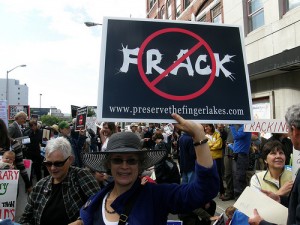 Later today, several hundred New Yorkers, backed by at least 40 environmental organisations, are heading to attend a rally on Capitol lawn in Albany to protest against the dirty drilling technique of hydraulic fracturing or “fracking.”
Later today, several hundred New Yorkers, backed by at least 40 environmental organisations, are heading to attend a rally on Capitol lawn in Albany to protest against the dirty drilling technique of hydraulic fracturing or “fracking.”
Among the speakers will be Josh Fox, director of the award-winning anti-gas industry documentary “Gasland.”
Opponents of fracking have long contended that it seriously contaminates drinking water. One infamous shot in the film has someone able to “light” the water coming out of a tap, it is so polluted.
But the elephant in the room with fracking is not the pollution of drinking water. It is climate change.
The technique has revolutionised the domestic gas industry in America, spurred on by vast reserves of shale in America from which the gas is collected, and concerns over energy security. The boom has been built on the misconception that because it is gas it is cleaner than oil or coal, because far less carbon dioxide is produced.
Indeed such as the boom that the Energy Information Administration, the statistical branch of the Energy Department’s, estimates that shale gas will account for 45 per cent of total U.S. gas supply in 2035, up from 14 per cent in 2009.
However,the boom could soon go to bust.
Academics from Cornell University are due to publish research that concludes that fracking contributes as much to climate change as coal, due to its methane emissions, which is a highly potent greenhouse gas.
It is research that could potentially change the dynamics of the debate in the US – it is politically explosive.
The study contends that shale gas developed through fracking carries a higher greenhouse gas footprint because of high volumes of leakage of methane at the fracking site, which is something that fracking’s critics have been pointing out could well be an issue.
The academics argue that the methane emissions from fracking are so great that it “its greenhouse gas footprint” is comparable to coal over a century, but worse over two decades.
It says “The [greenhouse gas] footprint for shale gas is greater than that for conventional gas or oil when viewed on any time horizon, but particularly so over 20 years. Compared to coal, the footprint of shale gas is at least 20% greater and perhaps more than twice as great on the 20-year horizon and is comparable when compared over 100 years”.
It concludes: “The large GHG footprint of shale gas undercuts the logic of its use as a bridging fuel over coming decades, if the goal is to reduce global warming.”
Not surprising, even before publication, the oil industry is trying to torpedo the study. Energy consulting firm M.J. Bradley & Associates told the Hill, who got an advanced copy of the research.
“It needs to be understood as a study that has several key assumptions that are highly uncertain or based on limited data points.”
